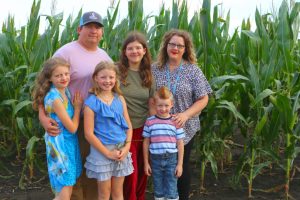June is National Dairy Month and fortscott.biz interviewed David and Lynda Foster, whose family operates Foster Dairy Farm southwest of Fort Scott on Hwy. 39 to get their perspective on the current state and the future of the dairy industry.
David and his wife, Addi, are in partnership with his mom and dad, Lynda and Gary Foster.
Lynda’s grandfather, Ed Davis began the farm in the 1940s, she said.
Now the fifth generation, David and Addi’s oldest daughters, Ansley, 15, and Mayla, 13 are helping on the farm.
The following is an interview with David and Lynda.
Tell about the state of dairy farms in Kansas.
“Currently there are 209 dairy farms in Kansas and while we may have lost numbers of dairy farming operations, we are growing in cow numbers with Kansas currently having about 142,000 mature milking cows,” Lynda Foster said. “Kansas is ranked 15th in the nation.”
“There is a new Hillmar Cheese plant in construction expected to come online in about 2.5 years from now, where we also expect to see an additional 100,000 cows to be added to the state,” she said.
The Hillmar Cheese Processing Plant will be a state-of-the-art facility in Dodge City, in western Kansas.
How did the pandemic effect your farm?
“We experienced primarily supply chain disruptions,” David Foster said. “It didn’t change the work that needed to be done daily. We still traveled to get supplies like alfalfa, and feed and mineral. It canceled annual meetings in organizations that we are a part of. Like everyone, there were certain precautions that were to be made if someone got sick.”
What is happening now in the industry?
“Exports are still up, and expected to be higher this year, 1 in 6 semi tanker loads of milk gets exported” Lynda said.
“Milk prices are on the rise and setting records in some areas, so are a lot of our inputs, especially feeds, fertilizers, fuels – all of these input costs are outpacing the increased milk price,” she said. “Some of the most notable current events in the dairy industry was, of course, the baby formula shortage.”
What is on the horizon for the dairy industry from your perspective?
“I believe that we will continue to see consolidation, dairy farms getting larger, smaller farms disappearing,” David said. “I believe that the days of families deriving their sole income from the dairy are gone. Today, a farmer on a smaller dairy, less than 300 cows, needs a spouse off-farm to make it and provide for their families additional income as well as health insurance.”
“Automated Milking Systems will continue to grow in use and will allow farms to alleviate the woes associated with a depleted/barely existent labor market,” he said. “Recent reports showed that for every person that doesn’t have a job, there are 2 jobs available. This means that farming operations struggle to compete in wages against other industries and also struggle to entice labor due to the traditional physical demands and long hours of a farming operation.”
Automatic, or robotic,milking systems usually operate without someone being present to supervise the milking process and have been in use for the past decade on commercial farms, according to sciencedirect.com
“I believe that you will see dairy farms continue to diversify operations to include other agricultural ventures that complement milking and farming, such as trucking or custom harvest, and hay operations,” he said.
“Technologies such as methane digestors will allow a value-added return from cow manure and allow dairies to derive additional profits,” David said. “Dairies will utilize solar and wind to reduce peak energy costs.”
“I am always probing and putting efforts into exploring options for emerging technologies that would make our operation more efficient,” David said. “The goal of sustainability is always to do more with less. We are the only dairy left in Bourbon County and one of a few left in all of southeast Kansas. There may be interest in adding on-farm processing in the future to serve the needs of this 4-state area with a local, quality, nutritional product.”
“I believe with food shortages touted and supply disruptions experienced, we will continue to feel an increasing demand for consumers to want to source local,” he said. “We saw this ramp up significantly in the beef industry as consumers wanted to buy direct from the farmer. We see this in farmer’s markets. Other areas have supported their local operations, and we may not be far from considering, but to expand our operations to include processing, or other technologies, we have to expand our team of people that can share our vision and hopes for a better future.”
“Some of the biggest obstacles I see for dairy and maybe shared by all businesses, will be labor, inflation, which is then tied to interest and increased taxes, and supply prices and availability,” David said.
